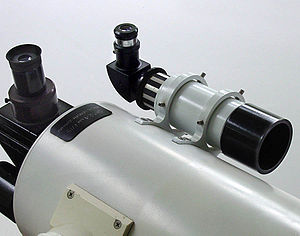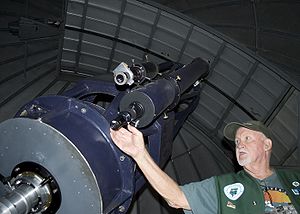
Finderscope
Encyclopedia


Telescope
A telescope is an instrument that aids in the observation of remote objects by collecting electromagnetic radiation . The first known practical telescopes were invented in the Netherlands at the beginning of the 1600s , using glass lenses...
mounted atop the main astronomical
Astronomy
Astronomy is a natural science that deals with the study of celestial objects and phenomena that originate outside the atmosphere of Earth...
telescope and pointed in the same direction. The finderscope usually has a much smaller magnification than the main telescope can provide and therefore can see more of the sky. This helps in locating the desired astronomical object
Astronomical object
Astronomical objects or celestial objects are naturally occurring physical entities, associations or structures that current science has demonstrated to exist in the observable universe. The term astronomical object is sometimes used interchangeably with astronomical body...
in the night sky. Some finderscopes have crosshair
Crosshair
A reticle is a net of fine lines or fibers in the eyepiece of a sighting device, such as a telescope, a telescopic sight, a microscope, or the screen of an oscilloscope. The word reticle comes from the Latin "reticulum," meaning "net." Today, engraved lines or embedded fibers may be replaced by a...
s to mark exactly where the main telescope is looking.
Finderscopes usually come with a designation of the form AxB, where A is the magnification
Magnification
Magnification is the process of enlarging something only in appearance, not in physical size. This enlargement is quantified by a calculated number also called "magnification"...
and B is the aperture
Aperture
In optics, an aperture is a hole or an opening through which light travels. More specifically, the aperture of an optical system is the opening that determines the cone angle of a bundle of rays that come to a focus in the image plane. The aperture determines how collimated the admitted rays are,...
of the finderscope's objective lens in millimeters; for example, a 6x30 finderscope means a finderscope with a 30 mm objective and a magnification of 6x. This designation is in the same format used by most binoculars
Binoculars
Binoculars, field glasses or binocular telescopes are a pair of identical or mirror-symmetrical telescopes mounted side-by-side and aligned to point accurately in the same direction, allowing the viewer to use both eyes when viewing distant objects...
.
A 6x30 finderscope is the minimum useful size for a finderscope on an amateur telescope, and an 8x50 or larger finderscope is preferred. Many inexpensive telescopes come with 5x24 finderscopes or smaller, and in some cases the true aperture is even less due to the presence of an internal aperture stop.
Most finderscopes have one of three viewing orientations:
| Type | Eyepiece Eyepiece An eyepiece, or ocular lens, is a type of lens that is attached to a variety of optical devices such as telescopes and microscopes. It is so named because it is usually the lens that is closest to the eye when someone looks through the device. The objective lens or mirror collects light and brings... mount |
Image orientation |
|---|---|---|
| Standard | Straight through | Upside down and reversed (i.e. rotated 180 degrees) |
| Right-angle | 90 degrees | Backwards (mirror-image) |
| Correct orientation | 90 degrees | Correct |
Telescopes also use finders based on the reflector (reflex) sight
Reflector sight
A reflector or reflex sight is a generally non-magnifying optical device that allows the user to look through a partially reflecting glass element and see an illuminated projection of an aiming point or some other image superimposed on the field of view...
. This type of "finderscope" does not magnify the image at all, but instead puts a reticle generated by collimating optics in the users field of view so that one can locate an object very quickly. The image seen through the finder is exactly the same as what can be seen with the naked eye with an illuminated crosshair seeming to float in space at infinity
Infinity
Infinity is a concept in many fields, most predominantly mathematics and physics, that refers to a quantity without bound or end. People have developed various ideas throughout history about the nature of infinity...
.

